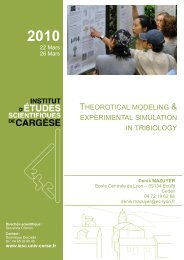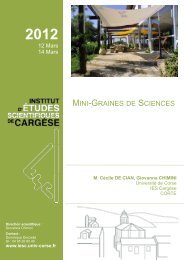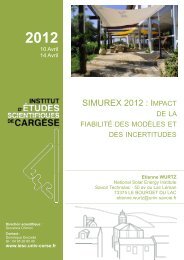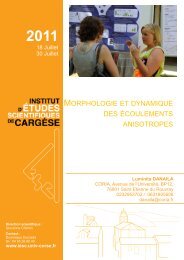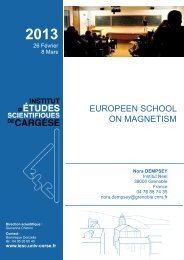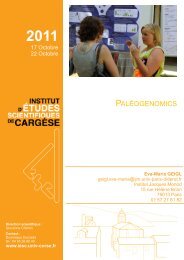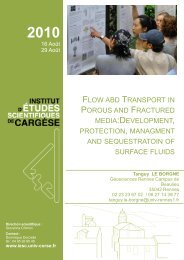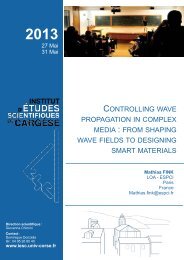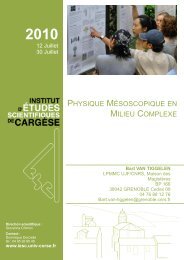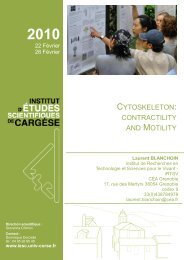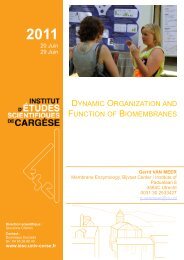nanoelectronics - Institut d'Études Scientifiques de Cargèse (IESC)
nanoelectronics - Institut d'Études Scientifiques de Cargèse (IESC)
nanoelectronics - Institut d'Études Scientifiques de Cargèse (IESC)
Create successful ePaper yourself
Turn your PDF publications into a flip-book with our unique Google optimized e-Paper software.
Friday<br />
Electron focusing in grapheme<br />
Csaba Péterfalvi 1,2 , László Oroszlány 1 , József Cserti 1 , Colin Lambert 2<br />
1 Department of Physics of Complex Systems, Eötvös University, Budapest, H-1117,<br />
Hungary<br />
2 Department of Physics, Lancaster University, Lancaster, LA1 4YB, UK<br />
We propose an implementation of a valley selective electronic Veselago lens, as a planar<br />
potential step in bilayer graphene. We <strong>de</strong>monstrate that low energy electrons radiating from<br />
a point source and being scattered by an appropriately oriented potential step can be<br />
focused again coherently within the same band. The phenomenon is due to the negative<br />
refraction in<strong>de</strong>x which is a consequence of the anisotropy in the dispersion relation caused<br />
by the trigonal warping effect. We also consi<strong>de</strong>r an effective Hamiltonian in which the<br />
electron-electron interaction [1], as well as external mechanical strain [2] is taken into<br />
account, and we show how this affects the focusing phenomenon. Recent studies on the<br />
electron-phonon interaction in bilayer graphene [3] suggest that the electrons' free path can<br />
be long enough even on room temperatures to enable the focusing.<br />
[1] Y. Lemonik, I. L. Aleiner, C. Toke, and V. I. Fal’ko, Spontaneous symmetry breaking and<br />
Lifshitz transition in bilayer graphene, Phys. Rev. B 82, 201408 (2010)<br />
[2] M. Mucha-Kruczyński, I. L. Aleiner and V. I. Fal’ko, Strained bilayer graphene: Band<br />
structure topology and Landau level spectrum, Phys. Rev. B 84, 041404 (2011)<br />
[3] K. M. Borysenko, J. T. Mullen, X. Li, Y. G. Semenov et al, Electron-phonon interactions in<br />
bilayer graphene, Phys. Rev. B 83, 161402 (2011)<br />
__________________________________________________________________________<br />
Theory of scanning gate microscopy<br />
C. Gorini 1 , R. A. Jalabert 1 , W. Szewc 1 , S. Tomsovic 2 and D. Weinmann 1<br />
1 <strong>Institut</strong> <strong>de</strong> Physique et Chimie <strong>de</strong>s Matérieux <strong>de</strong> Strasbourg, UMR 7504, CNRS-UdS, 23 rue<br />
du Loess, BP 43, 67034 Strasbourg Ce<strong>de</strong>x 2, France<br />
2 Department of Physics and Astronomy, PO Box 642814, Washington State University,<br />
Pullman, WA 99164-2814, USA<br />
The conductance change due to a local perturbation in a phase-coherent nanostructure is<br />
calculated [1]. The general expressions to first and second or<strong>de</strong>r in the perturbation are<br />
applied to the scanning gate microscopy of a two-dimensional electron gas containing a<br />
quantum point contact. The relation between the conductance change and the local current<br />
<strong>de</strong>nsity is discussed relying on an extension of the Szafer-Stone mo<strong>de</strong>l for a constriction [2].<br />
[1] R. A. Jalabert, W. Szewc, S. Tomsovic and D. Weinmann, What is measured in the<br />
scanning gate microscopy of a quantum point contact? Phys. Rev. Lett. 105 166802 (2010)<br />
[2] A. Szafer and A. D. Stone, Theory of Quantum Conduction through a Constriction Phys.<br />
Rev. Lett. 62 300 (1989)



